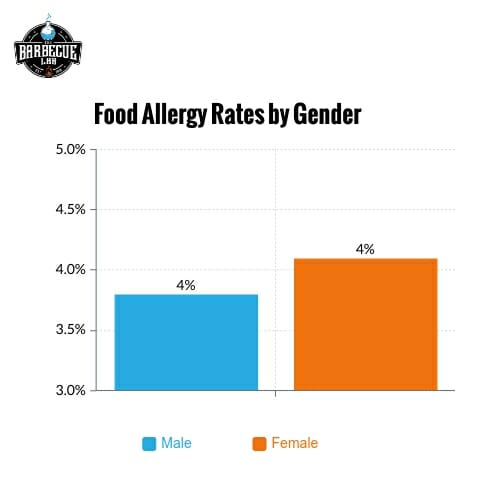Food Allergy Statistics
(Updated April 2024)
In this article, we will look at the difference between food allergies and food intolerance. We will see how prevalent food allergies are, the number of emergencies related to food allergies, allergies & cost of treatment, the main foods that cause most allergic responses, food allergies in children, peanut allergies, and finally, we will look at some reasons why some think food allergies are increasing.
Quick Food Allergy Statistics
What is a true food allergy?
A food allergy is a medical condition where certain proteins in food that are normally harmless trigger an immune response that can affect multiple organs. These immune responses to the food allergens can range from mild reactions, like itchiness or hives, to severe reactions, like throat swelling and difficulty breathing.
Some allergens trigger an anaphylactic response which is sudden and can result in death. 150-200 people die in America each year from food allergies.
It is estimated that 50% of self reported food allergy cases are false. Some may be describing their symptoms as a food allergy when it should be labeled as a food intolerance.
What is the difference between a food intolerance and food allergy?
According to the Mayo Clinic, a food intolerance can show some of the same signs and symptoms of a food allergy. However, most food intolerance symptoms are not as serious and are localized to the digestive tract. Lactose intolerance is a prime example.
Chronic conditions like celiac disease are not considered food allergies or food intolerances, they are considered an autoimmune disease. In the case of celiac disease, gluten is the main offender. Eating gluten triggers a whole-body immune response where the body attacks itself, resulting in malabsorption and a host of other complications.
Number of people with food allergies
There are about 32 million Americans who have food allergies. Often, they may have an allergy to more than one type of food, or have other chronic illnesses like asthma or eczema.
Females tend to have a slightly higher rate of food allergies at 4.1%, while 3.8% of males have a diagnosis of a food allergy.

1 in 10 adults and 1 in 13 children have some type of food allergy. Food allergies require a medical diagnosis and treatment plan. Some may have to carry a life saving epi-pen at all times in case of a potential fatal reaction.
While 10% of adults have food allergies, in a survey of more than 40,000 Americans, a researcher found that almost 19% of adults think they have food allergies. He noted that many of the symptoms described by the respondents are more along the lines of food intolerance, and not an actual allergy.
Food Allergies can cause emergencies
While it is not our goal to downplay the discomfort that can come from food intolerance, food allergies have the potential to cause emergencies. It’s estimated that 200,000 people require emergency medical care each year due to food allergies.
A survey that asked adults diagnosed with some type of food allergy were asked to select all symptoms that were present when eating a food that they are allergic to. As we can see, the allergic reaction can affect the whole body, including the skin, digestive tract & circulatory system. The most reported symptom was itching or swelling in the mouth. Swelling in the mouth could block airways, making it potentially life threatening.

Allergies & Cost
All types of allergies, including food allergies, cost Americans around $25 Billion per year for treatment. Americans pay around $5.5 billion per year in out of pocket costs to treat allergies.
Unfortunately, the cost of life saving epinephrine in an EpiPen has increased by 514% since 2007. An EpiPen uses an auto-injectable system so it is immediately available for use.
Some people have opted to take the lower cost of the epinephrine and draw it up into a syringe for injection. While this sounds reasonable, when you’re panicking because you can’t breathe you have a better chance of giving yourself the wrong amount. The EpiPen reduces user error.
There have been some good strides more recently in making EpiPens more affordable. Auvi-Q for example may cost as little as $0 for commercially insured patients and they also offer a financial assistance program for those who qualify.
What types of food cause the most allergies in America?
What is the number 1 food allergy? While there are over 170 different foods can cause allergies, there are 8 types of food that cause 90% of all food allergies. Shellfish accounts for the most cases, followed by milk and peanuts. The list continues with tree nuts, fin fish, eggs, wheat, and soy. Sesame also accounts for about 500,000 cases of food allergies.

Food Allergies in Children
Food allergies affect 5.6 million or roughly 6.5% of children in the United States. Almost 5% of children under 5 have a food allergy. Children with food allergies are 2-4 times more like to develop asthma than children without food allergies. People with food allergies and asthma both may be at increased risk for the more severe or fatal reactions.

Over 40% of children with a food allergy will have to be treated in the emergency department, as 40% of children with a food allergy will have a life threatening reaction. Severe or fatal reactions to food can happen at any age. Teenagers and young adults have the highest risk of fatal anaphylaxis due to food. 41% of children with food allergies carry an EpiPen with them at all times.
On top of being ever vigilant to avoid trigger foods, children with food allergies are also 2 times more likely to get bullied than those without.
Peanut Allergies & Children
1.2 % of the entire American population has a peanut allergy, while 2.5% of American children suffer. A peanut allergy affects ¼ of all children with a food allergy. While some children outgrow their food allergies, it is estimated that 80-90% of people with a peanut allergy will have it for life.
Why are food allergies increasing?
The prevalence of food allergies are increasing, especially in industrialized societies. There are many theories on the cause of the increase, many of which can be attributed to the way of life for industrialized societies.
The first thing to remember is that a food allergy is an immune response. Our immune system is there to help us fight off bad bugs, but there are also good bugs that live on your skin and in your digestive tract. They help in building a strong immune system.
Good hygiene practices may account for some of the increases in food allergies. We may keep things too clean, we may be washing away those “good bugs” and our immune systems don’t need to learn how to develop immunity to certain triggers.
Many children don’t spend the time outside like they used to and there is less exposure to microbes found in the dirt. If they do spend time outside, and are covered in sunscreen, they may also lack vitamin D. Vitamin D is vital for a healthy immune system.
Some believe that consumption of genetically modified foods is increasing in allergies, but the jury is still out on that one. In genetically modified foods, a new protein is developed to protect the plant and increase yield (perhaps to help end world hunger), and those proteins could be considered allergens. As with any new breed of plant, whether happening naturally or through genetics, it still has the potential to elicit an allergic reaction in someone.
Whatever the case may be, we can see that the number of insurance claims for food allergy complaints has increased significantly throughout the United States.

Food Allergy Statistics
Resources and Downloads
Data Sources
